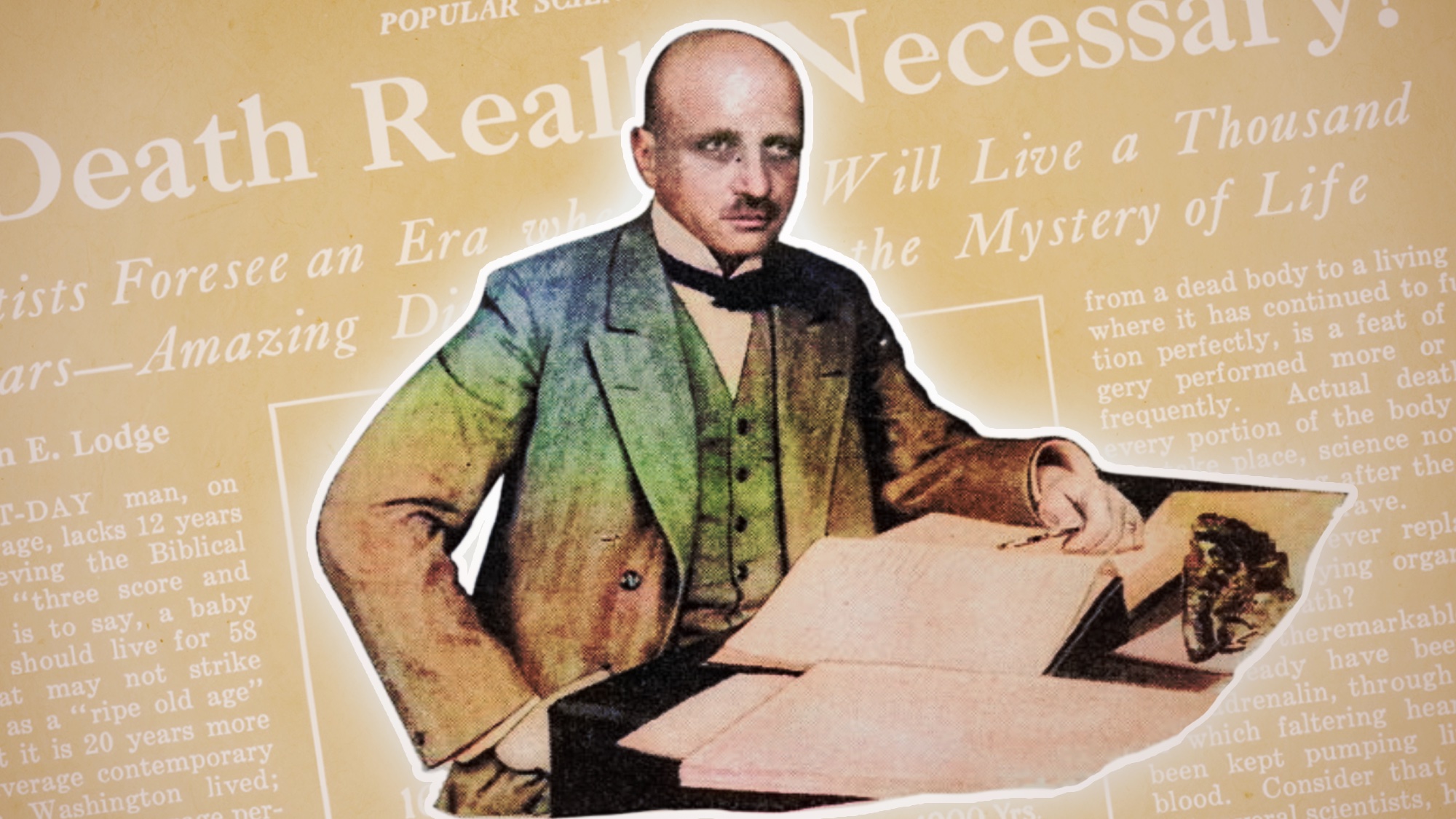Now Reading: 100 years ago, scientists predicted we’d live to 1,000 years old
-
01
100 years ago, scientists predicted we’d live to 1,000 years old
100 years ago, scientists predicted we’d live to 1,000 years old

Get the Popular Science daily newsletter💡
Breakthroughs, discoveries, and DIY tips sent every weekday.
When Frederick Grant Banting discovered how to isolate insulin from animals in 1921, the young Canadian doctor—a WWI veteran and former farm boy—changed the calculus of diabetes forever. Prior to the 1920s, the disease killed more than 80 percent of preteen diabetic children. Banting’s breakthrough replaced the sometimes toxic remedy goat’s rue, or Galega officinalis, a flowering plant with glucose-lowering properties derived from guanidine. His discovery came during a wave of medical optimism fueled by new scientific tools and knowledge that were rapidly unlocking the mysteries of human anatomy, disease, and aging.
The foundations for this optimism had been building for decades. Germs were first discovered in the 1880s, ushering in the golden age of bacteriology and numerous life-saving vaccines. Vitamins got their name in the early 1900s when London-based Polish biochemist Casimir Funk—one of many scientists seeking cures for common diseases by linking them to vital nutrient deficiencies—combined “vital” and “amines.” Rickets led to the discovery of vitamin D, scurvy to vitamin C, and vitamin B was tied to beriberi, a disease that causes weakness, weight loss, confusion, and, in extreme cases, death. Meanwhile, anesthesia transformed surgery from a grisly performing art with low survival rates to more precise procedures conducted in germ-free operating rooms. Bit by bit, medicine appeared to be conquering many of humanity’s most pernicious plagues and thereby extending our average lifespan.
By July 1925, Popular Science writer John E. Lodge even suggested that humans might soon be able to extend their life expectancy to 1,000 years. “Thanks to the efforts of science in combatting the ravages of disease, the average span of life is increasing every year,” Lodge wrote. “Are we to expect, then, that in time science will succeed in prolonging the average life until, like Methuselah, we measure our lives by centuries instead of by years.” Lodge envisioned a world where aging could be halted by replacing worn-out enzymes, transplanting organs, or manipulating an elusive “vital spark.” Scientists, he claimed, might be on the verge of conquering death itself.

A hundred years later, we’re still not there, but we continue to chase immortality with the same zest. Just as a century ago, today that quest is fueled not by glamorous breakthroughs—even if history makes it seem so—but by painstaking, collaborative scientific research, yielding fresh medical insights. In place of insulin, vaccines, and vitamins, today we’re captivated by gene-editing, cellular reprogramming, and immunotherapy. From biohackers injecting stem cells in search of cellular youth to billionaires like Bryan Johnson leaning on wearable tech for preventative health, blood plasma exchanges, and caloric restriction, the goal of outsmarting death hasn’t diminished—the elixirs are just more sophisticated.
And yet, we’ve come a long way in a century. In 1925, the average American lifespan was 58 years; today, it’s 78.4 years, according to the US Centers for Disease Control. Such progress might seem meager compared to our grandiose early 20th century expectations, but the trend suggests that by the next century the average American would live to be a centenarian. There’s even reason to believe—as there was in 1925—that current promising research might yield treatments as soon as the next few decades that significantly extend our lifespans while improving disease resistance.

Consider how researchers in Singapore have extended the lives of mice 25 percent by blocking the protein interleukin-11. Scientists at the University of Rochester have successfully transferred a longevity gene to mice from naked mole rats, which live ten times longer than similar rodents. The gene, known for producing high molecular weight hyaluronic acid, or HMW-HA, extended mouse lives by 4.4% and improved their overall health. The researchers now aim to transfer these benefits to humans.
In an ironic twist, a century after Banting’s insulin discovery displaced goat’s rue, a derivative of the pink-and-white flowering plant is back in favor. Metformin, a biguanide medication, has become one of the leading drugs for managing type 2 diabetes. Like its medieval predecessor, which was used for everything from increasing milk flow in livestock to alleviating plague symptoms, metformin has been similarly used or tested in myriad applications: as an antimalarial drug, influenza treatment, lactation enhancer, arthritis remedy, and cardiovascular medicine. Now, scientists have begun to piece together the mystery of metformin’s versatility by mapping how it works at a cellular level. Recent research has shown that it may slow or inhibit cellular changes leading to inflammation and age-related diseases, extending lifespan.
The cellular aging story stretches back to the late 19th century. As scientists were discovering germs, developing vaccines, uncovering the link between vital nutrients and common diseases, and improving surgery, evolutionary biologist August Weismann theorized that human cells had replication limits, which explained why the ability to heal diminished with age. By the 1960s, scientists had proven Weismann correct. Today, researchers are learning to halt and reverse cellular aging through reprogramming, an idea first attempted in the 1980s and advanced by Nobel Prize recipient Shinya Yamanaka, who discovered how to revert mature, specialized cells back to their embryonic, or pluripotent state, enabling them to regenerate into new tissue like liver cells or teeth.
Read more ‘What a Difference a Century Makes—Or Not’ series
But none of this means we’re approaching thousand-year lifespans. Most longevity interventions work only in tightly controlled laboratory settings or short-lived animals. Translating them into humans presents entirely different—and enormously complex—challenges. Even if we managed to double or triple the human lifespan, equally complex social challenges would follow: Who would get access to life-extending therapies? How do we support a society where most people live into their third or fourth century? What psychological toll does such extreme longevity take?
The optimism of 1925 wasn’t misplaced; it was simply premature. It still might be, but today’s longevity researchers are armed with more sophisticated tools and a deeper understanding of biological processes. Whether today’s tools and knowledge will finally enable us to defy death remains to be seen. If there’s a lesson to draw from the past hundred years, however, it’s that life extension is incremental, fragile, and often humbling. We’ve added decades to average life expectancy, transformed once-fatal diseases into manageable conditions, and dramatically improved the quality of life in later years. That’s no small feat—but it’s not immortality.

More deals, reviews, and buying guides
The PopSci team has tested hundreds of products and spent thousands of hours trying to find the best gear and gadgets you can buy.























